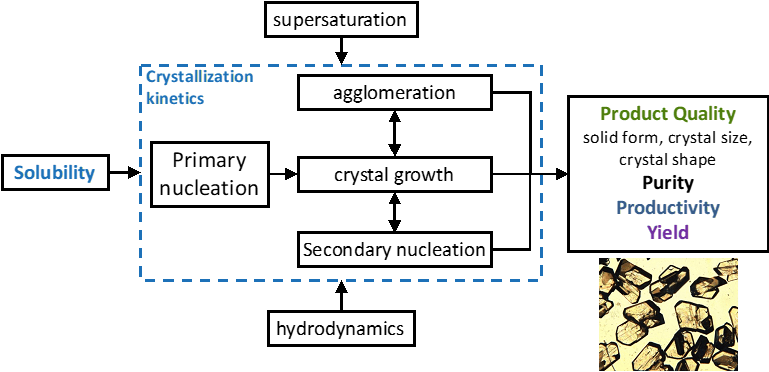About the webinar
Crystallization is a critical industrial separation process, producing crystalline products of which the value is closely tied to the product quality [1]. This product quality is defined by the form, size, shape, and purity of the crystals. While trying to achieve a high product quality also sufficient yield and productivity are important specifications to fulfill when designing a crystallization process. These specifications necessitate a systematic approach to process design.
A key enabler of efficient crystallization process design is accurate solubility data. The solubility or phase diagram provides vital information about solution equilibrium, serving as the foundation for reliable design and operation. Recent advancements in commercial equipment have made it easier to obtain high-quality solubility measurements, even for complex multicomponent systems [2,3]. This simplifies the determination of the conditions under which specific yields and productivities can be achieved, but also specific polymorphs or multicomponent crystals.
Equally important is a thorough understanding of crystallization kinetics [4]. Industrial crystallization involves the interplay of nucleation, crystal growth, secondary nucleation, and agglomeration. The stochastic nature of nucleation makes its control in terms of form and rate a long-standing challenge. Methods such as induction time distribution measurements offer insights into nucleation rates and mechanisms [5,6]. Such insights lead to product quality control strategies that improve the crystallization process design, for instance by controlling the polymorphic form.
The webinar concludes with a simple workflow for crystallization process design, integrating solubility and kinetic measurements to address quality challenges and optimize production by crystallization.
References:
[1] J.H. ter Horst, C. Schmidt, J. Ulrich, Fundamentals of industrial mass crystallization (Chapter 32), In: Handbook of Crystal Growth, 2nd Ed., Editor: Peter Rudolph, Vol 2B: Bulk Crystal Growth, Growth Mechanisms and Dynamics, Elsevier (2015). https://doi.org/10.1016/B978-0-444-63303-3.00032-8
[2] W. Li, M. De Groen, H.J.M. Kramer, R. De Gelder, P. Tinnemans, H. Meekes, J.H. Ter Horst, Screening approach for identifying cocrystal types and resolution opportunities in complex chiral multicomponent systems, Crystal Growth & Design 21 (1), 112-124. https://doi.org/10.1021/acs.cgd.0c00890
[3] C. Mack, J. Hoffmann, J. Sefcik, J.H. ter Horst, Phase diagram determination and process development for continuous antisolvent crystallizations, Crystals 12 (8), 1102. https://www.mdpi.com/2073-4352/12/8/1102
[4] R.J. Davey, S.L.M. Schroeder, J.H. ter Horst, Nucleation of Organic Crystals—A Molecular Perspective, Angewandte Chemie Int. Ed. 52(8) 2013 2166–2179. https://doi.org/10.1002/anie.201204824
[5] S. Jiang, J.H. ter Horst, Crystal Nucleation Rates from Probability Distributions of Induction Times, Crystal Growth Design 11(1) (2011) 256–261. https://doi.org/10.1021/cg101213q
[6] J.H. ter Horst, C. Brandel, Measuring Induction Times and Crystal Nucleation Rates, Faraday Discuss. 179 (2015) 199, https://doi.org/10.1039/C4FD00230J
Watch the webinar video recording using the form on this page or download the webinar presentation slides from the Publications section.

